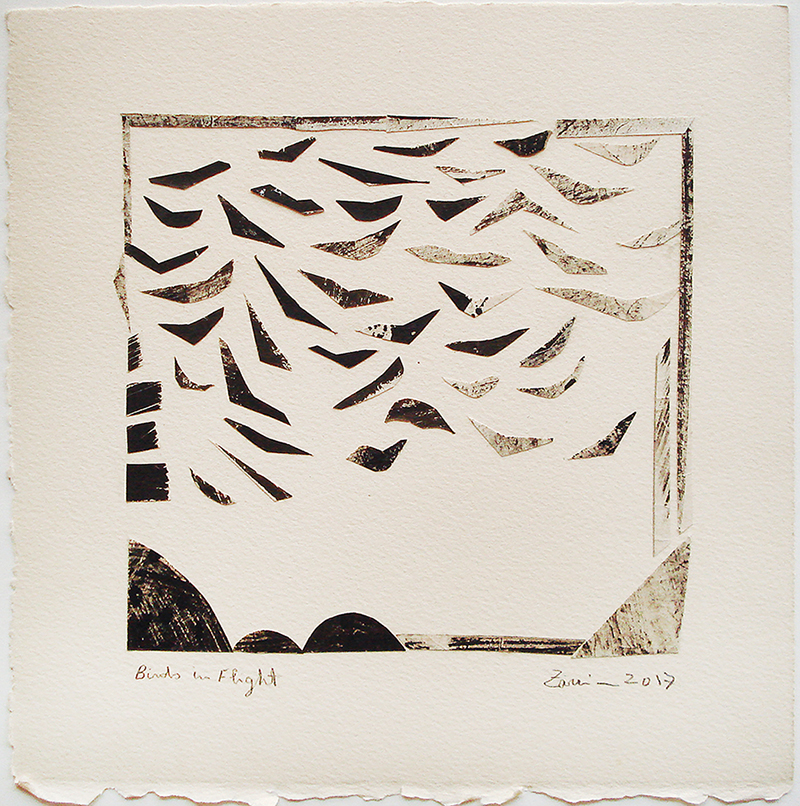Shows
Zarina Hashmi’s “Weaving Darkness and Silence”


Some wounds never heal. Some might even find temporary relief from scratching away at open gashes, as if this redresses the pain. Such is the case of Zarina Hashmi, who chisels away at blocks for her woodcut prints and cuts away at paper for her collages, all the while attempting to remediate the silence that surrounds both personal and collective traumas of the past, particularly in relation to the 1947 Partition of India and Pakistan.
This endeavor for respite from feelings of pain and suffering could be intuited throughout the artist’s exhibition “Weaving Darkness and Silence” at Gallery Espace. Zarina’s practice has always been an attempt to transgress the limits of language in representing memory, exile and social cataclysms. In the never-before-exhibited woodcut prints, etchings and collages on display, she further withdraws into a particular quality of these notions—the repressed presence of these topics from everyday consciousness, with varying forms of darkness as metaphors for it. For instance, the penetrating loneliness of the night is laid out in parallel vertical black lines in Silent Night (2017), which carve out negative spaces against a ground of white paper.
Paper for Zarina is like skin—malleable and susceptible to aging. As a consequence, her intimate treatment of the material takes on visceral qualities, bringing to mind the physicality of her aging body, and the melding of body and emotional suffering. In works such as Untitled (2017), archways from the artist’s childhood home in Aligarh—to which she never had the opportunity to return—are cut out from handmade paper, crushed to depict the texture of aging skin, in turn suggestive of a haunting memory that is perhaps inscribed on her body. In a series of untitled collages from 2017, made from etchings on handmade paper, a similar texture is visible, indicating more indelible loss.


Architectural plans from the artist’s memory are also rendered in collages. Black paper strips are reconfigured in different compositions, tracing the architectural layouts of Zarina’s childhood home in Aligarh, her studio in New York—where she has been living for many years—and her barsati (rooftop house) in New Delhi, from a different time in her life. Occasionally, the black outlines are violently interrupted by a streak of red. These still-decipherable forms convulse into disarray as they break apart into a burst of lines, only for the artist to put them together again in asymmetrical, geometric shapes. Here, the strips of paper, which are carefully glued together, seem to suit the precariousness of recalling the past. It is almost as if they were jolted out of the faux certainty of memory to reveal themselves for what they are—an illusion. Further along, the collages morph from their linearity into aviatic forms, suspended in space, as seen in the work Birds in Flight (2017), to counter the neat paper cuttings of her architectural plans.
Darkness cannot exist without light, or at least the possibility of it. In another series shown in the exhibition, specks of gold and pewter leaf—materials Zarina has been working with since 2000—shine through white tissue paper and Somerset Antique paper. These compositions, which betray a glimmer of hope, give way to darker works, such as the show’s title exhibit, Weaving Darkness and Silence (2016), in which a dense wash of Sumi ink threatens to drown out the white of the paper. In Untitled (2017), where strips of black handmade paper are neatly woven together, the darkness seems to eclipse the light entirely.

In “Weaving Darkness and Silence,” each work seems to progressively deconstruct propositions made by earlier pieces in the exhibition, such as light yielding to complete darkness and architectural plans that get dismantled. There seems to be no way out, no escape route from the weight of memory and trauma of exile. Woodcut prints such as Behind the Fence (2017) and Running Lines (2017) depict dead ends and barriers of barbed wire and mesh. In a collage made of pewter leaf titled Laying Bricks (2017), viewers are faced with a brick wall. The only possibility of redemption that the exhibition indicates is the making of the works themselves. It is the artist’s process of confronting both darkness and silence by casting them repeatedly, over and over again, which yields relief and catharsis.
Zarina Hashmi’s “Weaving Darkness and Silence” is on view at Gallery Espace, New Delhi, until March 3, 2018.







